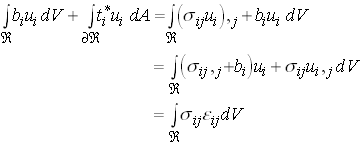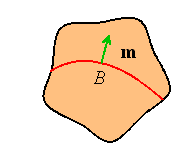 EN224: Linear Elasticity
EN224: Linear Elasticity 
Division of Engineering
8. Energy Theorems and Applications
As always, energy methods provide a powerful way of approaching problems in linear elasticity. Energy methods can be used to obtain approximate solutions to boundary value problems. They can often be used to obtain rigorous bounds on the stiffness of an elastic structure or solid. Energy methods also provide new insight into general issues concerning uniqueness and existence of solutions to boundary value problems. Finally, several numerical techniques for solving elastic boundary value problems are based on energy principles.
In this section we will prove the most important energy theorems in linear elasticity and discuss some of their applications.
8.1 The Principle of Virtual Work
The principle of virtual work has nothing to do with linear elasticity, but it is convenient to start thinking about energy methods by reviewing a principle that you’ve probably seen before.
Let ![]() be a state of stress satisfying
be a state of stress satisfying

Furthermore, let ![]() be a displacement field on
be a displacement field on ![]() and define
and define
Then
This is known as the Virtual Work equation.
Proof: It has been suggested that every result in solid mechanics is obtained by applying the divergence theorem. So, observe that
Hence

Where we have used the equilibrium equations (including the symmetry of stress) to obtain the last line.
The virtual work equation is not particularly interesting. The converse is much more exciting:
Let ![]() be a symmetric stress field satisfying
be a symmetric stress field satisfying
for all displacement and strain fields with
Then

Proof: For sufficiently smooth ![]() , we may write
, we may write
Then, use the divergence theorem to express the virtual work equation as
Recall that we required the virtual work equation to be satisfied for all displacement fields, so in particular, we may choose
with
Then
Next, suppose that the displacement field satisfies
Then
This completes our proof.
Why is this useful? Well, it gives us a new way to think about equilibrium in a deformable solid. For example, it allows us to extend our ideas about equilibrium to stress fields which have jump discontinuities.

Let ![]() be a region, and suppose that
be a region, and suppose that![]() has a jump discontinuity
across some surface B.
has a jump discontinuity
across some surface B.
We now define an equilibrium state of stress to be one that satisfies the virtual work equation for all displacement fields. It follows that
Hence